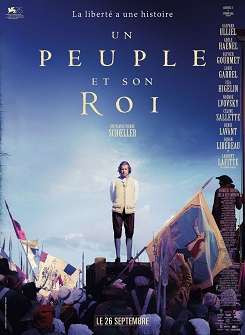A People and Its King is the story of two irreconcilable entities, which will gradually separate. One must die for the other to live: “Louis must die so that the nation may live.” It is Robespierre, portrayed by a restrained and excellent Louis Garrel, who expresses this in a speech he actually gave in 1792.
The two worlds are incompatible, the old and the new regime. It is a transfer of power, inevitable, inexorable.
Pierre Schoeller makes this decisive power struggle the subject of his film. The staging already suggests the paradoxes and difficulties of a royal power at the end of its rope.
Of course, in 1789 when it all begins, it is a king and his people; it is this immutable hierarchy that has dominated for centuries. But in 1792 when Louis XVI (a remarkable Laurent Laffitte) ascends the scaffold, it is a people and their king, up to the point of killing him. In three years, the balance of power has reversed.
Scenes with the king contrast with scenes with the people. Thus we discover the heart of the Parisian Revolution with the Faubourg Saint-Antoine neighborhood at the foot of the Bastille, historically one of the hotspots of the Revolution with the Réveillon riots, a factory in the neighborhood in 1789.
Pierre Schoeller wants to put the people back at the heart of the revolution: a glassmaker (Olivier Gourmet, perfect as usual) working in the shadow of the Bastille fortress, laundresses (Adèle Haenel, Isia Higelin, Céline Sallette), orphans, girls of no consequence, poor and dirty boys, often illiterate. They too are caught up in the upheavals of the Revolution.
We also find many revolutionaries who we enjoy following in their dealings at the Constituent Assembly: the terrifying Marat – almost frightening (Denis Lavant), the eloquent Danton, the absolutist Saint-Just, the phlegmatic Robespierre. The figures parade at the bar, in the logical confusion of the time, and tear each other apart over the fate of Louis XVI.
The sessions at the Assembly are quite fascinating since we follow different visions of the Republic and the Revolution, with no one able to stop or moderate them in practice. There is the theory, the grand speeches, and the reality.
The film does not judge. It is commendable. The Revolution is a machine that ran away, surpassing its supporters and creators.
The staging is sumptuous: candlelight, very realistic and well-researched costumes and sets. Everything is full of details that bring the whole to life.


